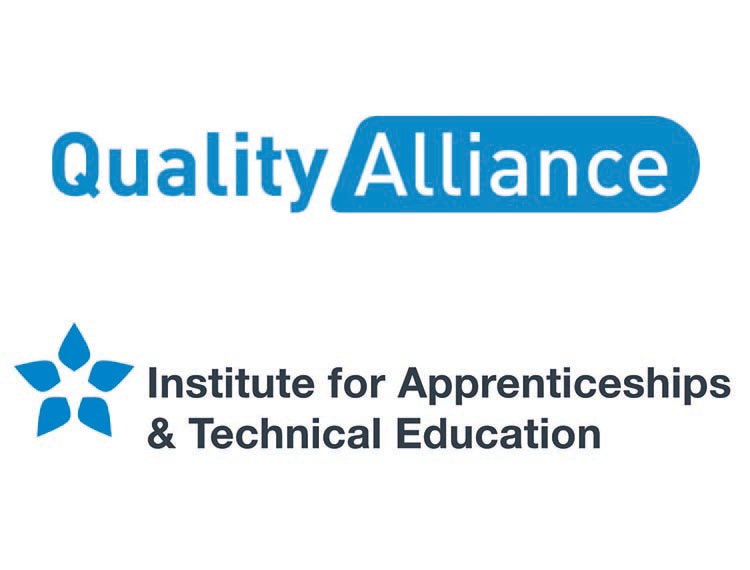The Quality Strategy for apprenticeships

Quality Strategy Best practice statements March 2019
The Quality Strategy sets out best practice expectations before, during, and after apprenticeships. The Strategy has been developed by regulatory bodies, concerned with ensuring apprenticeship quality, that have come together to create the Quality Alliance.
The alliance, chaired by the Institute, includes:
- The Education and Skills Funding Agency,
- Ofsted,
- Ofqual,
- Quality Assurance Agency for Higher Education (QAA) and
- The Office for Students (OfS).
The Association of Employment and Learning Providers, and the Association of Colleges, the Federation of Awarding Bodies (FAB) and Universities UK also attend and contribute to these meetings as observers.
The Strategy will help us to ensure the highest quality in the design and delivery of apprenticeships that guarantee the highest possible standards with employers at the heart of it.
Before apprenticeship
- PARTNERSHIP: Evidence that the apprenticeship on offer is of high quality, with the roles and responsibilities of the apprentice, training provider and employer including the job description and training plan to develop all required knowledge, skills and behaviours (KSBs) clearly set out in the commitment statement.
- OCCUPATION: Confirmation that employers design and approve occupational standards that consider progression, breadth and transferability at their heart and clearly set out the knowledge, skills and behaviours required to be occupationally competent, ensuring they remain relevant and up-to-date.
- JOB: Employers ensure they have a genuine job role that allows the apprentice to consolidate and improve the KSBs relating to the standard and that they have made appropriate planning arrangements to support the apprentice when they arrive, including enabling the apprentice to spend 20% of their time as off-the-job training.
- TRAINING: Assurance that only training providers with staff having appropriate, contemporary knowledge of the industry and the ability to design high quality training programmes that delivers at least 20% off-the-job training tailored to the individual apprentices’ needs based on an assessment of their initial KSBs, are approved to deliver apprenticeship training on the Register of Apprenticeship Training Providers.
- EPA: Assurance that employers have access to at least one end-point assessment organisation possessing the relevant experience and access to sufficient, suitably qualified assessors to develop valid, reliable and manageable assessments, drawing on clear, implementable and employer-approved end-point assessment (EPA) plans.
During apprenticeship
- PARTNERSHIP: Ensure there is effective and meaningful on-going dialogue between the apprentice, employer, training provider and end-point assessment organisation so that all parties are aware of whether they are on track and how to raise concerns if they are not.
- OCCUPATION: Ensure that the standard is relevant to jobs across all types of employers, including SMEs with take up from a range of employers, and with training providers teaching the entire breadth of the occupation in a way which delivers the envisaged preparation for subsequent employment in the occupational field, rather than focus on job-specific training.
- JOB: Demonstrable evidence of a high quality apprenticeship that is a paid job with at least 20% off-the-job training, where the apprentice will be undertaking appropriate, meaningful work, supported by competent colleagues and with access to a named workplace mentor.
- TRAINING: Evidence that appropriately trained staff monitor the apprentices’ progress which is regularly reviewed, and that training is tailored accordingly, to ensure the apprentice learns new KSBs, is appropriately challenged, achieves the appropriate level of English and Maths, and is prepared to showcase their competency at their end-point assessment.
- EPA: Confirmation through External Quality Assurance that assessment is valid, reliable, manageable and independent, providing a high-quality experience that allows apprentices to showcase their competence and gives confidence that they have achieved the right standard.
After apprenticeship
- PARTNERSHIP: All parties continue to support and deliver apprenticeships, having seen the benefit that apprenticeships can bring both to the business and to the individual.
- JOB: Measure that an apprentice continues in employment (or higher study) following the successful completion of their apprenticeship and is supported to find a subsequent role that makes use of their apprenticeship, with an expectation that they would see progression, whether in form of a promotion, an increased salary or the ability to specialise further.
- TRAINING: Evidence that apprentices who complete a high-quality training programme are signed off as occupationally competent by their employer and pass the end-point assessment as their training has provided them with the requisite knowledge, skills and behaviours.
- EPA: Evidence that EPA is a credible and accurate assessment of occupational competence and that successfully completing an apprenticeship is widely recognised as a significant achievement that proves occupational competence, confers status and allows apprentices to progress in work.











Responses